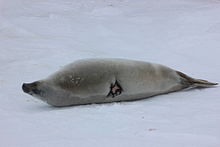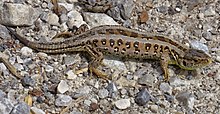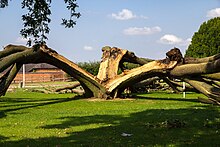Injury
 From Wikipedia - Reading time: 6 min
From Wikipedia - Reading time: 6 min

Injury is physiological damage to the living tissue of any organism, whether in humans, in other animals, or in plants.
Injuries can be caused in many ways, including mechanically with penetration by sharp objects such as teeth or with blunt objects, by heat or cold, or by venoms and biotoxins. Injury prompts an inflammatory response in many taxa of animals; this prompts wound healing. In both plants and animals, substances are often released to help to occlude the wound, limiting loss of fluids and the entry of pathogens such as bacteria. Many organisms secrete antimicrobial chemicals which limit wound infection; in addition, animals have a variety of immune responses for the same purpose. Both plants and animals have regrowth mechanisms which may result in complete or partial healing over the injury. Cells too can repair damage to a certain degree.
Taxonomic range
[edit]Animals
[edit]
Injury in animals is sometimes defined as mechanical damage to anatomical structure,[1] but it has a wider connotation of physical damage with any cause, including drowning, burns, and poisoning.[2] Such damage may result from attempted predation, territorial fights, falls, and abiotic factors.[2]
Injury prompts an inflammatory response in animals of many different phyla;[3] this prompts coagulation of the blood or body fluid,[4] followed by wound healing, which may be rapid, as in the cnidaria.[3] Arthropods are able to repair injuries to the cuticle that forms their exoskeleton to some extent.[5]
Animals in several phyla, including annelids, arthropods, cnidaria, molluscs, nematodes, and vertebrates are able to produce antimicrobial peptides to fight off infection following an injury.[1]
Humans
[edit]
Injury in humans has been studied extensively for its importance in medicine. Much of medical practice, including emergency medicine and pain management, is dedicated to the treatment of injuries.[6][7] The World Health Organization has developed a classification of injuries in humans by categories including mechanism, objects/substances producing injury, place of occurrence, activity when injured and the role of human intent.[8] In addition to physical harm, injuries can cause psychological harm, including post-traumatic stress disorder.[9]
Plants
[edit]
In plants, injuries result from the eating of plant parts by herbivorous animals including insects and mammals,[10] from damage to tissues by plant pathogens such as bacteria and fungi, which may gain entry after herbivore damage or in other ways,[11] and from abiotic factors such as heat,[12] freezing,[13] flooding,[14] lightning,[15] and pollutants[16] such as ozone.[17] Plants respond to injury by signalling that damage has occurred,[18] by secreting materials to seal off the damaged area,[19] by producing antimicrobial chemicals,[20][21] and in woody plants by regrowing over wounds.[22][23][24]
Cell injury
[edit]Cell injury is a variety of changes of stress that a cell suffers due to external as well as internal environmental changes. Amongst other causes, this can be due to physical, chemical, infectious, biological, nutritional or immunological factors. Cell damage can be reversible or irreversible. Depending on the extent of injury, the cellular response may be adaptive and where possible, homeostasis is restored.[25] Cell death occurs when the severity of the injury exceeds the cell's ability to repair itself.[26] Cell death is relative to both the length of exposure to a harmful stimulus and the severity of the damage caused.[25]
References
[edit]- ^ a b Rennolds, Corey W.; Bely, Alexandra E. (29 September 2022). "Integrative biology of injury in animals". Biological Reviews. 98 (1): 34–62. doi:10.1111/brv.12894. ISSN 1464-7931. PMC 10087827. PMID 36176189.
- ^ a b de Ramirez, Sarah Stewart; Hyder, Adnan A.; Herbert, Hadley K.; Stevens, Kent (2012). "Unintentional injuries: magnitude, prevention, and control". Annual Review of Public Health. 33: 175–191. doi:10.1146/annurev-publhealth-031811-124558. ISSN 1545-2093. PMID 22224893.
- ^ a b Sparks, Albert (1972). Invertebrate Pathology Noncommunicable Diseases. Academic Press. pp. 20, 133. ISBN 9780323151962.
- ^ Cerenius, Lage; Söderhäll, Kenneth (6 November 2010). "Coagulation in Invertebrates". Journal of Innate Immunity. 3 (1): 3–8. doi:10.1159/000322066. ISSN 1662-811X. PMID 21051883. S2CID 20798250.
- ^ Parle, Eoin; Dirks, Jan-Henning; Taylor, David (2016). "Bridging the gap: wound healing in insects restores mechanical strength by targeted cuticle deposition". Journal of the Royal Society Interface. 13 (117): 20150984. doi:10.1098/rsif.2015.0984. ISSN 1742-5689. PMC 4874426. PMID 27053653.
- ^ Maerz, Linda L.; Davis, Kimberly A.; Rosenbaum, Stanley H. (2009). "Trauma". International Anesthesiology Clinics. 47 (1): 25–36. doi:10.1097/AIA.0b013e3181950030. ISSN 1537-1913. PMID 19131750. S2CID 220567282.
- ^ Ahmadi, Alireza; Bazargan-Hejazi, Shahrzad; Heidari Zadie, Zahra; et al. (2016). "Pain management in trauma: A review study". Journal of Injury and Violence Research. 8 (2): 89–98. doi:10.5249/jivr.v8i2.707. ISSN 2008-4072. PMC 4967367. PMID 27414816.
- ^ "International Classification of External Causes of Injury (ICECI)". World Health Organization. Archived from the original on 17 October 2004. Retrieved 22 September 2023.
- ^ Agarwal, Tulika Mehta; Muneer, Mohammed; Asim, Mohammad; et al. (2020). "Psychological trauma in different mechanisms of traumatic injury: A hospital-based cross-sectional study". PLOS ONE. 15 (11): e0242849. Bibcode:2020PLoSO..1542849A. doi:10.1371/journal.pone.0242849. ISSN 1932-6203. PMC 7703890. PMID 33253298.
- ^ Tarr, S. A. J. (1972). "Plant injury due to insects, mites, nematodes and other pests". Principles of Plant Pathology. London: Macmillan. pp. 126–137. doi:10.1007/978-1-349-00355-6_9. ISBN 978-1-349-00357-0.
- ^ Cappelli, Seraina Lisa; Koricheva, Julia (2 July 2021). "Interactions between mammalian grazers and plant pathogens: an elephant in the room?". New Phytologist. 232 (1). Wiley: 8–10. doi:10.1111/nph.17533. ISSN 0028-646X. PMID 34213785. S2CID 235708670.
- ^ Smillie, R.M.; Nott, R. (1979). "Heat Injury in Leaves of Alpine, Temperate and Tropical Plants". Functional Plant Biology. 6 (1). CSIRO Publishing: 135. doi:10.1071/pp9790135. ISSN 1445-4408.
- ^ Burke, M. J.; Gusta, L. V.; Quamme, H. A.; Weiser, C. J.; Li, P. H. (1976). "Freezing and Injury in Plants". Annual Review of Plant Physiology. 27 (1). Annual Reviews: 507–528. doi:10.1146/annurev.pp.27.060176.002451. ISSN 0066-4294.
- ^ Kramer, Paul J. (1 October 1951). "Causes of Injury to Plants Resulting from Flooding of the Soil". Plant Physiology. 26 (4). Oxford University Press: 722–736. doi:10.1104/pp.26.4.722. ISSN 0032-0889. PMC 437542. PMID 16654407.
- ^ Nelson, Scot C. (July 2008). "Lightning Injury to Plants" (PDF). Plant Disease (PD-40).
- ^ Heath, R. L. (1980). "Initial Events in Injury to Plants by Air Pollutants". Annual Review of Plant Physiology. 31 (1). Annual Reviews: 395–431. doi:10.1146/annurev.pp.31.060180.002143. ISSN 0066-4294.
- ^ Hill, A. C.; Pack, M. R.; Treshow, M. (1961). "Plant injury induced by ozone". Phytopathology. 51. OSTI 5518148.
- ^ Turlings, Ted C.; Tumlinson, James H. (1992). "Systemic release of chemical signals by herbivore-injured corn". Proceedings of the National Academy of Sciences. 89 (17): 8399–8402. Bibcode:1992PNAS...89.8399T. doi:10.1073/pnas.89.17.8399. PMC 49926. PMID 11607325.
- ^ Sun, Qiang; Rost, Thomas L.; Matthews, Mark A. (2008). "Wound-induced vascular occlusions in Vitis vinifera (Vitaceae): Tyloses in summer and gels in winter1". American Journal of Botany. 95 (12). Wiley: 1498–1505. doi:10.3732/ajb.0800061. ISSN 0002-9122. PMID 21628157.
- ^ Shigo, Alex L. (1985). "Compartmentalization of Decay in Trees". Scientific American. 252 (4): 96–103. Bibcode:1985SciAm.252d..96S. doi:10.1038/scientificamerican0485-96. hdl:2027/uva.x002416568. ISSN 0036-8733.
- ^ González-Lamothe, Rocío; Mitchell, Gabriel; Gattuso, Mariza; Diarra, Moussa; Malouin, François; Bouarab, Kamal (31 July 2009). "Plant Antimicrobial Agents and Their Effects on Plant and Human Pathogens". International Journal of Molecular Sciences. 10 (8). MDPI AG: 3400–3419. doi:10.3390/ijms10083400. ISSN 1422-0067. PMC 2812829. PMID 20111686.
- ^ Shigo, Alex L. (1985). "How tree branches are attached to trunks". Canadian Journal of Botany. 63 (8): 1391–1401. doi:10.1139/b85-193.
- ^ O'Hara, Kevin L. (2007). "Pruning Wounds and Occlusion: A Long-Standing Conundrum in Forestry". Journal of Forestry. 105 (3): 131–138. doi:10.1093/jof/105.3.131. S2CID 10075580.
- ^ "Tree pruning guide". US Forest Service for the US Department of Agriculture. Archived from the original on 26 April 2007.
- ^ a b Wolf, Ronni; et al. (2011). Emergency Dermatology. Cambridge University Press. pp. 1–10. ISBN 9780521717335.
- ^ Cobb, J. P.; et al. (1996). "Mechanisms of cell injury and death". British Journal of Anaesthesia. 77 (1): 3–10. doi:10.1093/bja/77.1.3. PMID 8703628.
 KSF
KSF